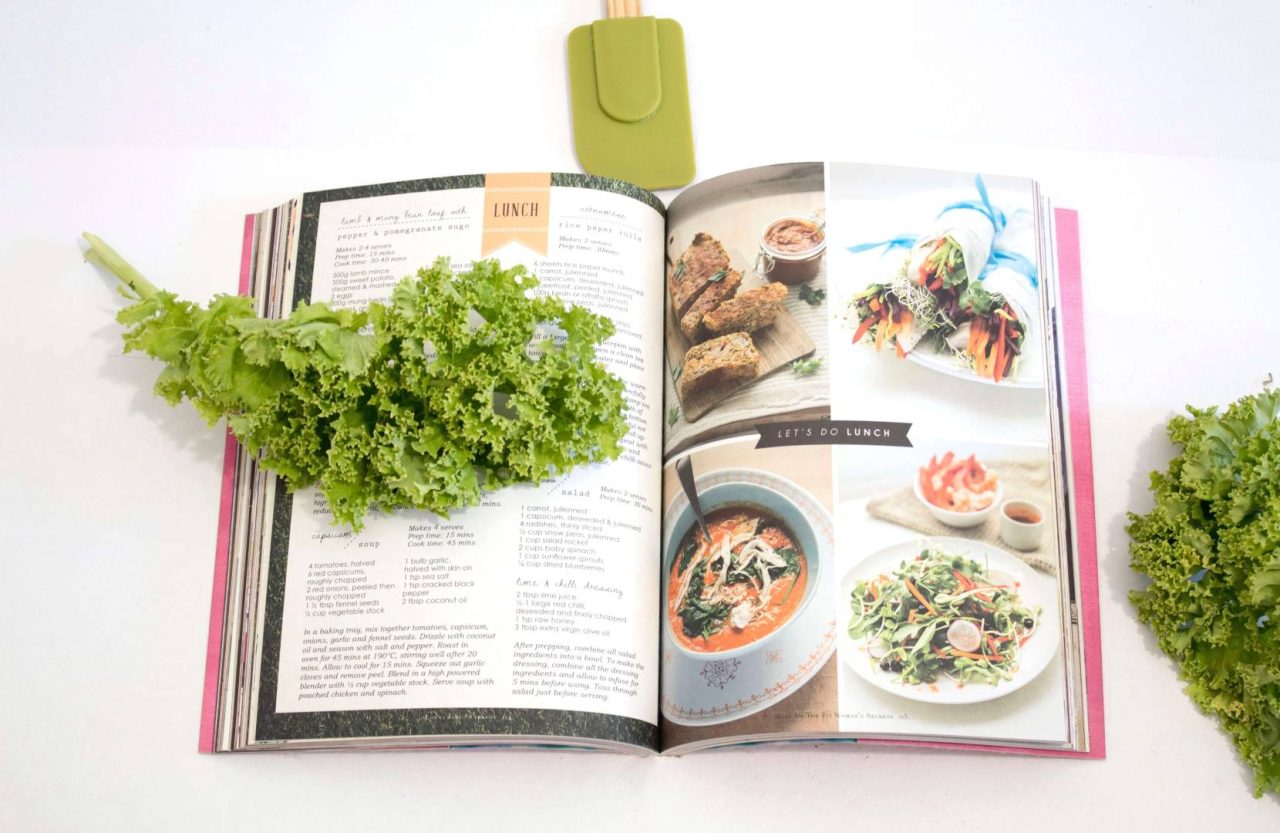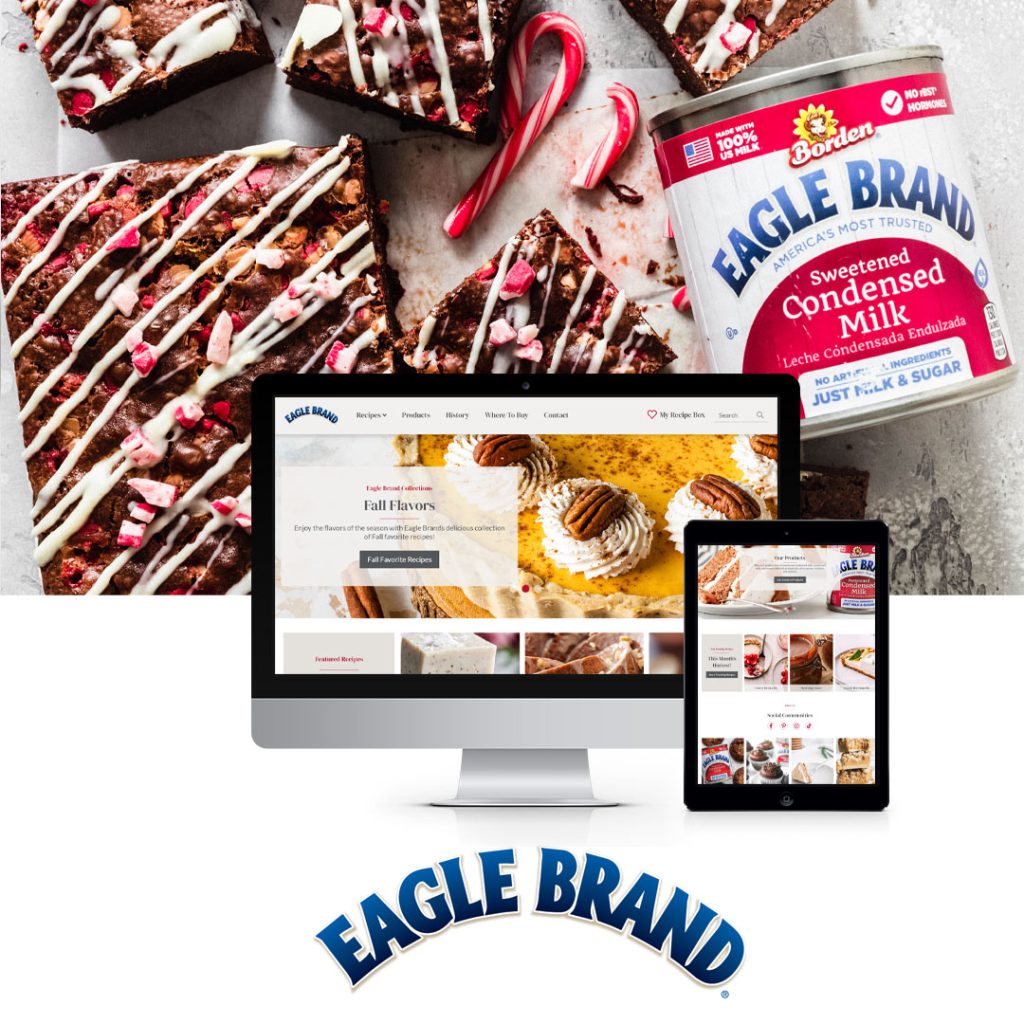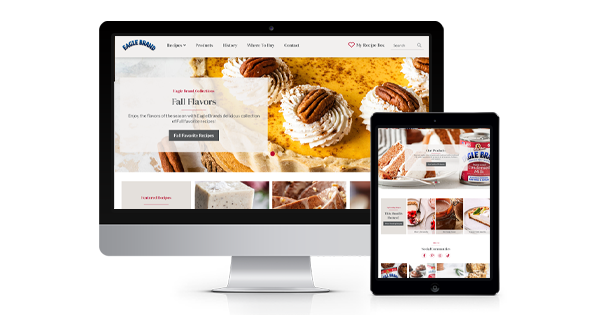Today, most industry-leading consumer goods brands, like Eagle Brand, include a recipe section as part of their web design. A recipe section is critical for driving traffic to a packaged goods brand’s website and creating interest in its products. Without a recipe page design that meets best practices, a brand is losing out on valuable conversion opportunities. That’s why Eagle Brand came to Idea Marketing Group, experts in consumer goods web design, to seek help creating the best recipe page design.
Eagle Brand is a well-known packaged goods brand that has been around for over 160 years. In 1865 Gail Borden introduced Eagle Brand condensed milk to fight food poisoning and other illnesses related to lack of refrigeration and preservation techniques. Since then the brand has changed a lot, but they still offer the same important baking ingredients that it started out with, along with some new additions.
The brand is most well known for its sweetened and condensed milk that is used in a variety of popular recipes. Holiday classics and other home staples rely on using condensed milk like the one offered by Eagle. Many of these recipes have been handed down for generations through family or friends. But as society advances the way people use and discover recipes have changed dramatically, and consumer goods brands need to adjust their marketing to stay successful. Factors like SEO, web design, and user navigation are of critical importance in recipe page design.
How to Improve Your Recipe Page SEO Strategy
Today, recipes can be discovered with a quick google search, and the same is true for recipe ingredients. There are numerous recipes and ingredient options available. New demographics of customers are using technology to discover future favorite recipes. In order to capture these new customers, consumer packaged goods brands have had to adjust their marketing strategies.
With the modern online environment, brands need to focus on capturing online traffic and bringing search users to their website and their products. One of the best ways to do that is by creating a recipe page design that leverages SEO, in other words, a website recipe section that shows up in the first few search results on Google.

What exactly is SEO? SEO, or Search Engine Optimization, refers to numerous techniques that are implemented to increase a website’s domain authority, traffic, and consumer trust, and ultimately increase conversions! Specifically, SEO involves the strategizing and creation of optimized content meant to rank higher on search engine algorithms and be more easily discovered by a brand’s target audience.
You can learn more about SEO for your recipe page design from the below resources:
- The 10 Most Common Misconceptions About SEO (and why SEO is worth it!)
- 8 Expert SEO Tips to Improve Your Website in 2022
- Why Does SEO Take So Long?: 9 Essential Reasons Why (And What You Can Do to Shorten The Process)
A strong SEO strategy is important to consumer packaged goods brands because it is one of their main drivers of business. When a user discovers a recipe by the CPG brand that promotes their products, they are likely to order the products or search for the products in nearby stores. To be discovered, a brand has to make sure that its recipe page design is optimized for SEO and is engaging to users.
Once a user lands on the recipe section, the brand needs to make sure that they decide to stay. Otherwise, the user will navigate to another, more optimized recipe page from a competitor. There are many factors that go into creating the best recipe page design for a CPG brand, and each of them is critical to maximizing the page or section’s performance.
How to Create a Great Recipe Page Design for Your Consumer Packaged Goods Brand
It takes a lot of experience and insider knowledge to create the perfect recipe page for your CPG brand and might be best left to the experts. But if you are looking for areas that you can at least get started improving, there are several aspects of a great recipe page you should keep in mind for your brand.
General Factors of a Great Recipe Page
To get started creating a recipe page that stands out from the crowd, you need to make sure you consider the following for the recipe page web design.
Ease of Use – You need to make sure that your recipe page is easy for your audience to use. If you overcomplicate it, users aren’t going to stick around. Have clear sections and make the recipe itself easy to find. If you are going to include the recipe history, including a jump to recipe button.
Highlight Your Products – The whole point of the recipe page is to drive sales of your products, so you need to ensure they are prominently displayed. Include links that lead customers to where they can order or purchase the product in person. It’s also a good idea to feature pictures of your products so customers make the association and can easily recall your brand when they go to buy later. If your customers don’t recall what your products look like, they might buy a competitor’s.
Use Appealing Images – This one is a given but we can’t ignore it. Your recipe page should include absolutely mouthwatering pictures of the finished product that entice your target audience to try their hand at making it. Images are incredibly important in your content, we cover this more in-depth in our blog Why Images are Important in Your Content Marketing.
Allow Users to Easily Share – If users find a product they love then you want to make sure that they have the option to easily share it with family, friends, and the rest of their social network. Make sure that your recipe page is connected to major social channels like Facebook, Instagram, Pinterest, and other channels like text and even email! Making sure that your recipes are shareable will create more demand for your products.
Technical Aspects of a Top Recipe Page

We’ve briefly covered the general aspects of a great recipe page, but that’s not all it takes to create a recipe page that will rank above the competition. There are many technical aspects that go into creating a top recipe page as well.
Use Image Alt Tags – We mentioned how important images are for your recipe page, but there are also some technical aspects you need to consider when using images on your recipe page design. Alt tags on all images are needed to assist screen readers and other accessibility software, and this also improves your SEO.
Downsize Images – Images also need to be compressed so their file size does not affect your website load speeds. Compressing the images will not hinder the quality but will ensure that your website’s SEO is not negatively affected by large file sizes.
Check Load Speeds – Load speeds are incredibly important to SEO, and slow load speeds will cause your website visitors to exit if they lag. Check your website load speeds to make sure this isn’t deterring traffic from your recipe page.
Use Keyphrases That Match Your Products – Make sure your recipe page is targeting keyphrases, which are most likely your product name and its variations. By including these in the content search engines will identify your recipe page as relevant content to user queries.
Meta Descriptions – These are an important part of SEO, think of them as a brief summary of your page that signals to users and search engines what the page is about. By using these correctly you can ensure that your recipe page gets discovered quickly.
By following these general guidelines you can start to improve your consumer goods recipe page and start attracting more traffic to your website. We also cover more factors that make a great recipe page in our recent blog, How to Create the Best Recipe Page Design for Your CPG Brand.
Creating a Popular Recipe Page for Eagle Brand
Eagle Brand already had a well-established recipe page on its website, but it wasn’t driving the traffic levels that it wanted. In order to improve their traffic levels, they came to the expert consumer goods web designers, Idea Marketing Group.
Addressing the Issues of the Eagle Brand Consumer Goods Web Design
Overall, Eagle was searching for several key improvements to its website and online presence. The Eagle team wanted a new, user-oriented consumer goods website with an updated focus and brand messaging. The new focus of the website needed to better reflect what their target audience could do with their products. An updated and improved recipe page design would be the key factor in creating a new website that met these criteria.
In addition to the updated website focus and recipe section overhaul, Eagle also wanted to make sure that the website was user-friendly, with emphasis on the user experience. The new Eagle Brand website needed to be easily navigable for its user demographic. A clean clear menu that allowed users to quickly and easily find what they were looking for was essential.
The website would also need to take into account the shift in user behavior. While desktop computers still make up a large portion of internet traffic, mobile has grown into a significant portion of search traffic. Mobile users also represent a key opportunity for consumer goods brands, as many users search on mobile devices while they are in the store searching for a product to buy. Eagle Brand’s new website needed to be mobile-friendly in order to capture this new segment of market traffic.
Finally, the website would need to be more manageable for the Eagle Brand team. The new website would be built so that it would be easy for their team to manage, and make updates as needed. For example, with the previous website, Eagle’s team struggled to update information and images to reflect seasonal changes or product highlights. To increase their control over the website these issues needed to be addressed.
Improving User Navigation, Site Manageability, and Updating the Recipe Page Section Through Leading Packaged Goods Web Design
We started by updating the messaging across the Eagle Brand website to adjust the focus. The new Eagle Brand website featured more emphasis on recipes and baked goods made using Eagle Brand products. Attractive images are featured prominently across the website pages with a distinct Call-to-Action that leads customers to products or recipes. The top menu bar was also reorganized to place special emphasis on their recipe pages and to provide clear navigation to other website sections.
One of the main objectives of this website redesign was a complete overhaul of the website’s recipe pages. The entire website recipe section needed to be updated to reflect current user behavior and meet recipe page best practices. Our team created recipe pages that aligned with recipe page best practices, meaning they were easy to read, share, and find the products used within the recipes. Links take users directly to where they can purchase the product or find it locally.

We also created a custom functionality that served as a way for users to save recipes they wanted to view later in a section called “My Recipe Box.” This option was present within the menu header across the website so users could always find it easily.
Other new website features like categories allows users to better refine their searches and find options in the categories that were of interest to them. The new recipe section also featured collections, so users could browse by options like ‘5 ingredients or less”, “no bake”, or “holiday.” With the updated recipe sections the user search was simplified.
Creating a Custom Importer to Manage the Recipe Page Imports
For the new Eagle Brand website, there were hundreds of recipes that would need to be added. To add each recipe would take months to complete and be a major drain on time resources for the Eagle team. To avoid this our team of web developers built a custom recipe importer to manage the recipe page imports. This custom functionality it saved the Eagle time and effort in launching their new recipe pages.
Using our knowledge of the best consumer goods website practices and recipe page design our team was able to create a new website that met all of the Eagle Brand team’s goals.
From a website design point of view, our team created a custom consumer packaged goods website with updated messaging and focus that also simplified the user flow, allowing customers to easily find the products they were looking for. There was a complete overhaul of the website’s recipe section; creating and organizing recipe pages that were easily filterable.

On the technical side of consumer goods web design, our team performed numerous upgrades to the website like our custom importer to manage the import of hundreds of unique recipes. The new website also allowed the Eagle team to easily make changes to the website images and text to keep up with their seasonal promotions and product highlights.
Overall the website was built with a variety of unique consumer packaged goods website features to meet the needs of our Eagle Brand. You can learn more about the Eagle Brand project in our portfolio.
Why Choose Idea for Consumer Packaged Goods Web Design
Eagle came to Idea Marketing Group because of our experience working with large-scale consumer goods brands and an in-depth understanding of important website factors, like the custom recipe page. In our web design portfolio, you’ll find our past projects with other major brands like Carmex, Bridgford Foods, and more.
Our team worked closely with the Eagle team to make sure we understood their goals, and what parts of their old website were causing them friction. We work hard to truly understand each client’s unique needs and build a custom web design that addresses their issues.
Looking to get custom consumer goods web design for your brand? Or need a new recipe page section to drive traffic to your product pages? Speak with one of our web design experts today to learn more about how we can help your brand!





